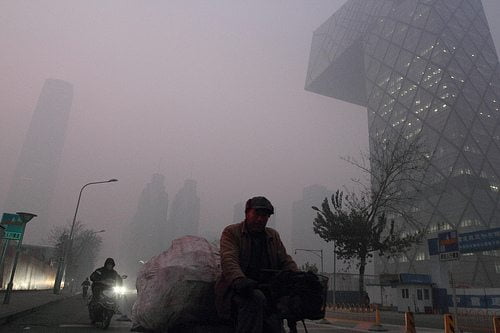

Environment
Beijing issues first ‘orange’ pollution warning amid smog crisis
Beijing has issued a three-day emergency pollution alert, warning residents to keep outdoor activities to a minimum and ordering some industries to limit production.
The Chinese capital issued its first ever orange alert – the second most severe ranking out of four in a recently introduced pollution monitoring plan – on Thursday.
The move followed the detection of the particulate matter PM2.5 at a concentration of 237 micrograms per cubic metre – nine times the levels recommended as being safe by the World Health Organisation (WHO) – near Tiananmen Square.
Residents have been asked to use public transport where possible, while barbeques and fireworks have been prohibited. Roads will also be frequently sprayed and construction sites must attempt to control dust levels using sprinklers.
Despite this, the Chinese government has faced criticism over the use of the new four colour warning system.
Earlier this month, PM 2.5 levels exceeding 500 micrograms per cubic metre were detected in the capital, yet the authorities only issued the mildest, blue-level alert.
In January, the second-mildest yellow alert was issued when PM2.5 levels reached 671 – 26 times the WHO’s recommended level.
If the most severe red warning was issued, the authorities say they have emergency plans to pull half of all the 5m cars in the city off the road. However, observers have questioned if the government would be willing to cause such disruption.
“When the alert is at a low level, the measures are not effective, but those for the high-level alert are not feasible,” Ma Jun, of the non-governmental Institute of Public and Environmental Affairs in Beijing, told the Associated Press.
“The government is reluctant to raise the alert level.”
China’s former health minister Chen Zhu recently estimated that the country’s air pollution – the fourth biggest killer in Beijing – accounts for up to 500,000 premature deaths each year.
In response to the crisis, the government has set up a $1.65 billion (£990m) fund offering rewards to companies that clean up their operations. It has also embarked on the world’s largest ever renewable energy drive, with plans to double the number of wind turbines it uses to generate electricity over the next six years.
A WWF report published this week estimated that China could generate 80% of its electricity from renewable sources by 2050.
Further reading:
Report: China can reduce emissions and grow economy simultaneously
China sets up $1.65bn fund to solve air pollution
China owes further £199bn to climate change efforts, says study


 Environment9 months ago
Environment9 months agoAre Polymer Banknotes: an Eco-Friendly Trend or a Groundswell?

 Environment11 months ago
Environment11 months agoEco-Friendly Home Improvements: Top 7 Upgrades for 2025

 Features8 months ago
Features8 months agoEco-Friendly Cryptocurrencies: Sustainable Investment Choices

 Features10 months ago
Features10 months agoEco-Friendly Crypto Traders Must Find the Right Exchange





























